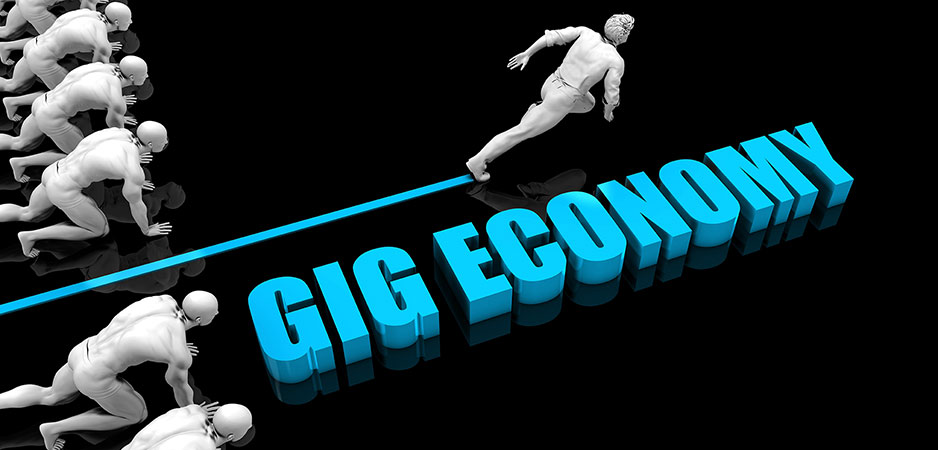The gig economy has exploded over the last decade, and now it seems like you can’t throw a rock without hitting someone who makes a living through it. Companies like Uber and Lyft rely on gig workers as an integral part of their business model, and increasingly more businesses are starting to shift toward using contractors and freelancers to do work that has been traditionally done by salaried or hourly employees. While this new sector of the economy does provide its workers with a decent amount of flexibility, there is a seriously dark side to the gig economy and how it affects American workers.
One of the benefits touted by those who back the gig economy is that, because workers don’t have a set schedule or a direct supervisor telling them what to do, it offers unprecedented freedom compared to traditional work. While this is true in a sense, it is also what makes the gig economy a quagmire for many of those working within it. The gig economy provides no upward mobility, and those who work within it have to deal with the instability that comes with only being able to work when work is available.
How Revolutionary Is the Fourth Industrial Revolution?
Gig workers are also responsible for far more than they would be in a traditional job. Not only do they have to fill out invoices for the work they accomplish and maintain a variety of working relationships with companies issuing the contracts they take up, but they are also solely responsible for making sure that they remain tax-compliant. There is no one taking money out of their checks in order to pay into Social Security, Medicare or federal and state taxes. When these workers are trying to live paycheck to paycheck from their gig work, this puts extra financial stress on their shoulders.
Cui Bono?
All of these things that make the gig economy terrible for those who actually participate in it are the same things that make it so appealing to companies. The gig economy allows businesses to forgo the hiring and training of specialists like writers, graphic designers or anyone with a skill set that they don’t want to invest resources into long term. The companies that rely on the gig economy to function benefit even further by not having to pay payroll taxes, as contractors and freelancers are not considered employees and have that burden shifted over to them.
There is no shortage of articles highlighting how the gig economy negatively impacts workers by showing the struggles that it puts on them. For example, since gig workers aren’t employees of a company, it is their duty to procure their own health insurance and make sure that they don’t fall behind on their tax obligations. Additionally, they forgo the discrimination protections, family leave protections, paid time off, unemployment insurance benefits and worker’s compensation protection that traditionally employed workers benefit from. So,cui bono? Who benefits?
The gig economy is structured in such a way that it massively benefits the companies that engage in it over the workers who participate in it. Freelancing and contracting work currently makes up 4.8% of the current GDP, more than either transportation and warehousing or construction, and there are projections that American workers engaging in the gig economy will reach 50% over the next decade. That would mean 50% of America’s workforce would not be able to take advantage of health care provided through employers or the slew of other benefits that companies are currently legally required to offer employees.
In a nutshell, the gig economy has gained so much ground because it dismantles workers’ rights that have been fought for over the last decade, effectively killing the labor movement while promising so-called “flexibility” to America’s working class. By slowly convincing people that their labor is only needed on-demand, companies and businesses are able to sidestep the legal protections put into place to help workers, taking the working world back into a system reminiscent of what was in place during the Industrial Revolution.
How It Will Affect the Future
The gig economy has become a veritable giant, with nearly 1,000 companies operating in over 100 countries, disrupting a variety of industries from transportation to staffing. Uber raked in $1.6 billion in revenue during Q4 of 2016, showing that the gig economy is certainly a viable business model that can generate a huge amount of profit at the moment. However, it is important to ask whether or not the growth that the gig economy has shown can remain stable going forward, or if the entire gig economy itself has any real longevity.
Where mechanization replaced employees within companies do to their inherent efficiency and lower cost over time, the gig economy is replacing traditional employees with other humans, many of whom are participating in the gig economy out of sheer desperation, as they are unable to procure the traditional employment that they are replacing. It is an ouroboric system wherein workers are consistently left with the short end of the stick.
How long is this system likely to last? Already, companies like Uber are running into trouble and are quickly approaching the limits of what the gig economy can be. As the gig economy enters the national spotlight, with California seeking to enact legislation that would require Uber — and other companies that rely on gig workers to make their business model function — to treat their workers more like traditional employees, the future of the gig economy is on shakier ground than previously thought.
However, as long as businesses are able to shift economic risks on to the workforce through the use of freelancers and independent contractors, we are unlikely to see the gig economy fade into nothing. It may simply become a very niche application for those looking for some supplemental income and businesses that don’t need to rely on collaborative efforts from its workforce to operate. Only time will tell.
The views expressed in this article are the author’s own and do not necessarily reflect Fair Observer’s editorial policy.
Support Fair Observer
We rely on your support for our independence, diversity and quality.
For more than 10 years, Fair Observer has been free, fair and independent. No billionaire owns us, no advertisers control us. We are a reader-supported nonprofit. Unlike many other publications, we keep our content free for readers regardless of where they live or whether they can afford to pay. We have no paywalls and no ads.
In the post-truth era of fake news, echo chambers and filter bubbles, we publish a plurality of perspectives from around the world. Anyone can publish with us, but everyone goes through a rigorous editorial process. So, you get fact-checked, well-reasoned content instead of noise.
We publish 3,000+ voices from 90+ countries. We also conduct education and training programs
on subjects ranging from digital media and journalism to writing and critical thinking. This
doesn’t come cheap. Servers, editors, trainers and web developers cost
money.
Please consider supporting us on a regular basis as a recurring donor or a
sustaining member.
Will you support FO’s journalism?
We rely on your support for our independence, diversity and quality.







